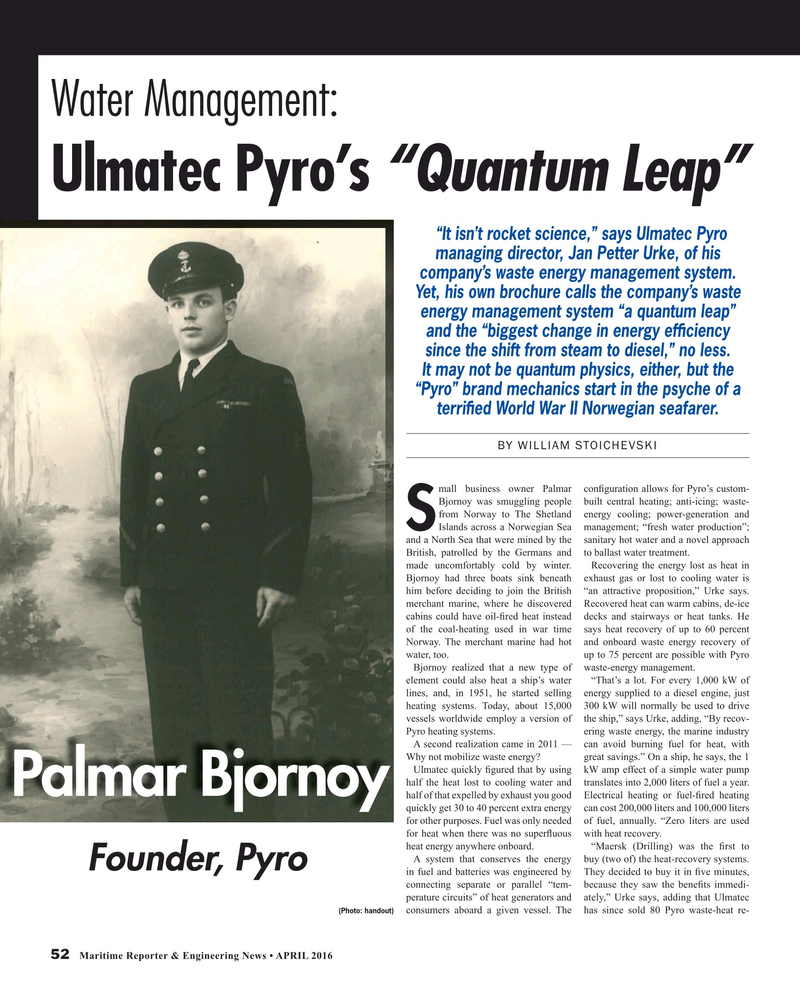
Page 52: of Maritime Reporter Magazine (April 2016)
The Offshore Annual
Read this page in Pdf, Flash or Html5 edition of April 2016 Maritime Reporter Magazine
Water Management:
Ulmatec Pyro’s “Quantum Leap” “It isn’t rocket science,” says Ulmatec Pyro managing director, Jan Petter Urke, of his company’s waste energy management system.
Yet, his own brochure calls the company’s waste energy management system “a quantum leap” and the “biggest change in energy ef? ciency since the shift from steam to diesel,” no less.
It may not be quantum physics, either, but the “Pyro” brand mechanics start in the psyche of a terri? ed World War II Norwegian seafarer.
BY WILLIAM STOICHEVSKI mall business owner Palmar con? guration allows for Pyro’s custom-
Bjornoy was smuggling people built central heating; anti-icing; waste- from Norway to The Shetland energy cooling; power-generation and
Islands across a Norwegian Sea management; “fresh water production”;
S and a North Sea that were mined by the sanitary hot water and a novel approach
British, patrolled by the Germans and to ballast water treatment. made uncomfortably cold by winter. Recovering the energy lost as heat in
Bjornoy had three boats sink beneath exhaust gas or lost to cooling water is him before deciding to join the British “an attractive proposition,” Urke says. merchant marine, where he discovered Recovered heat can warm cabins, de-ice cabins could have oil-? red heat instead decks and stairways or heat tanks. He of the coal-heating used in war time says heat recovery of up to 60 percent
Norway. The merchant marine had hot and onboard waste energy recovery of water, too. up to 75 percent are possible with Pyro
Bjornoy realized that a new type of waste-energy management. element could also heat a ship’s water “That’s a lot. For every 1,000 kW of lines, and, in 1951, he started selling energy supplied to a diesel engine, just heating systems. Today, about 15,000 300 kW will normally be used to drive vessels worldwide employ a version of the ship,” says Urke, adding, “By recov-
Pyro heating systems. ering waste energy, the marine industry
A second realization came in 2011 — can avoid burning fuel for heat, with
Why not mobilize waste energy? great savings.” On a ship, he says, the 1
Ulmatec quickly ? gured that by using kW amp effect of a simple water pump half the heat lost to cooling water and translates into 2,000 liters of fuel a year.
Palmar Bjornoy half of that expelled by exhaust you good Electrical heating or fuel-? red heating quickly get 30 to 40 percent extra energy can cost 200,000 liters and 100,000 liters for other purposes. Fuel was only needed of fuel, annually. “Zero liters are used for heat when there was no super? uous with heat recovery.
heat energy anywhere onboard. “Maersk (Drilling) was the ? rst to
A system that conserves the energy buy (two of) the heat-recovery systems. Founder, Pyro in fuel and batteries was engineered by They decided to buy it in ? ve minutes, connecting separate or parallel “tem- because they saw the bene? ts immedi- perature circuits” of heat generators and ately,” Urke says, adding that Ulmatec consumers aboard a given vessel. The has since sold 80 Pyro waste-heat re- (Photo: handout) 52 Maritime Reporter & Engineering News • APRIL 2016
MR #4 (50-57).indd 52 4/7/2016 1:10:47 PM

 51
51

 53
53
